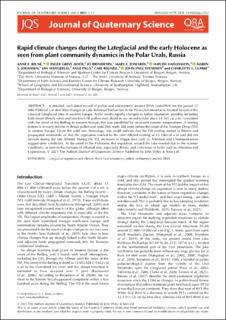| dc.contributor.author | Bjune, Anne E. | |
| dc.contributor.author | Greve Alsos, Inger | |
| dc.contributor.author | Brendryen, Jo | |
| dc.contributor.author | Edwards, Mary E. | |
| dc.contributor.author | Haflidason, Haflidi | |
| dc.contributor.author | Johansen, Maren S. | |
| dc.contributor.author | Mangerud, Jan | |
| dc.contributor.author | Paus, Aage | |
| dc.contributor.author | Regnéll, Carl | |
| dc.contributor.author | Svendsen, John-Inge | |
| dc.contributor.author | Clarke, Charlotte L. | |
| dc.date.accessioned | 2021-09-13T07:09:09Z | |
| dc.date.available | 2021-09-13T07:09:09Z | |
| dc.date.created | 2021-08-24T08:54:55Z | |
| dc.date.issued | 2021 | |
| dc.identifier.issn | 0267-8179 | |
| dc.identifier.uri | https://hdl.handle.net/11250/2775344 | |
| dc.description.abstract | A detailed, well-dated record of pollen and sedimentary ancient DNA (sedaDNA) for the period 15 000–9500 cal a bp describes changes at Lake Bolshoye Shchuchye in the Polar Ural Mountains, located far east of the classical Lateglacial sites in western Europe. Arctic tundra rapidly changed to lusher vegetation, possibly including both dwarf (Betula nana) and tree birch (B. pubescens), dated in our record to take place 14 565 cal a bp, coincident with the onset of the Bølling in western Europe; this was paralleled by increased summer temperatures. A striking feature is an early decline in Betula pollen and sedaDNA reads 300 years before the onset of the Younger Dryas (YD) in western Europe. Given the solid site chronology, this could indicate that the YD cooling started in Siberia and propagated westwards, or that the vegetation reacted to the inter-Allerød cooling at 13 100 cal a bp and did not recover during the late Allerød. During the YD, increases in steppe taxa such as Artemisia and Chenopodiaceae suggest drier conditions. At the onset of the Holocene, the vegetation around the lake reacted fast to the warmer conditions, as seen in the increase of arboreal taxa, especially Betula, and a decrease in herbs such as Artemisia and Cyperaceae. | en_US |
| dc.language.iso | eng | en_US |
| dc.publisher | Wiley | en_US |
| dc.rights | Attribution-NonCommercial-NoDerivatives 4.0 Internasjonal | * |
| dc.rights.uri | http://creativecommons.org/licenses/by-nc-nd/4.0/deed.no | * |
| dc.title | Rapid climate changes during the Lateglacial and the early Holocene as seen from plant community dynamics in the Polar Urals, Russia | en_US |
| dc.type | Journal article | en_US |
| dc.type | Peer reviewed | en_US |
| dc.description.version | publishedVersion | en_US |
| dc.rights.holder | Copyright 2021 The Authors | en_US |
| cristin.ispublished | true | |
| cristin.fulltext | original | |
| cristin.qualitycode | 1 | |
| dc.identifier.doi | 10.1002/jqs.3352 | |
| dc.identifier.cristin | 1928201 | |
| dc.source.journal | Journal of Quaternary Science | en_US |
| dc.identifier.citation | Journal of Quaternary Science, 2021. | en_US |

